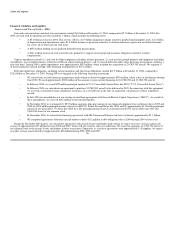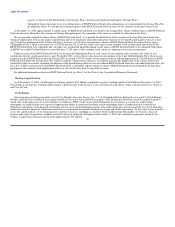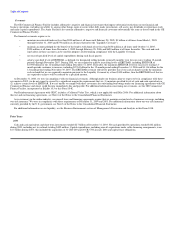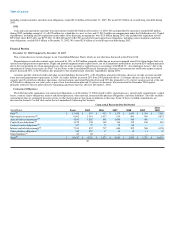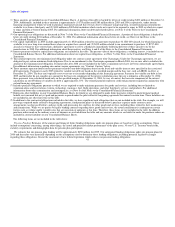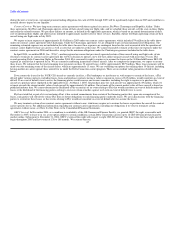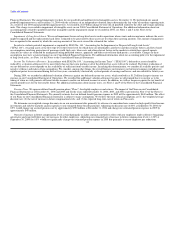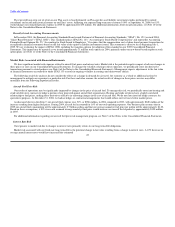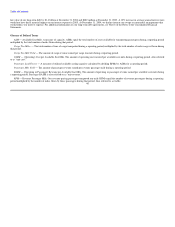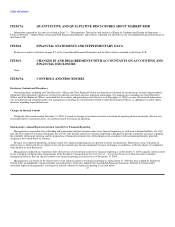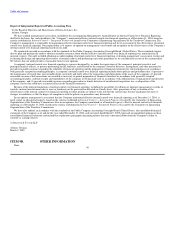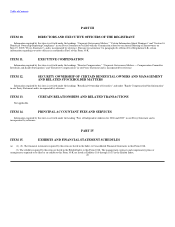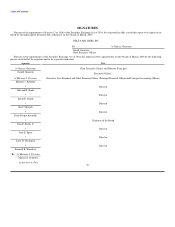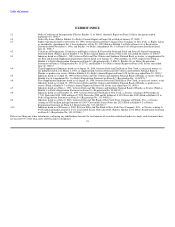Delta Airlines 2004 Annual Report Download - page 48
Download and view the complete annual report
Please find page 48 of the 2004 Delta Airlines annual report below. You can navigate through the pages in the report by either clicking on the pages listed below, or by using the keyword search tool below to find specific information within the annual report.
Table of Contents
Financial Statements. The annual impairment test date for our goodwill and indefinite-lived intangible assets is December 31. We performed our annual
goodwill impairment test as of December 31, 2004 with the assistance of an independent valuation firm to determine the fair value of our three reporting units.
As a result of our 2004 annual goodwill impairment tests, we recorded a $1.9 billion charge to write off all goodwill related to the ASA and Comair reporting
units. This charge is recorded in impairment of intangible assets on our 2004 Consolidated Statement of Operations. For additional information about our
accounting policy related to goodwill and other intangibles and the impairment charge we recorded in 2004, see Notes 1 and 5 in the Notes to the
Consolidated Financial Statements.
Impairment of Long-Lived Assets. We record impairment losses on long-lived assets used in operations when events and circumstances indicate the assets
might be impaired and the undiscounted cash flows estimated to be generated by those assets are less than their carrying amounts. The amount of impairment
loss recognized is the amount by which the carrying amounts of the assets exceed the estimated fair values.
In order to evaluate potential impairment as required by SFAS No. 144, "Accounting for the Impairment or Disposal of Long-Lived Assets"
("SFAS 144"), we group assets at the fleet type level (the lowest level for which there are identifiable cash flows) and then estimate future cash flows based
on assumptions involving projections of passenger yield, fuel costs, labor costs and other relevant factors in the markets in which these aircraft operate.
Aircraft fair values are estimated by management using published sources, appraisals and bids received from third parties, as available. Changes in these
assumptions may have a material impact on our Consolidated Financial Statements. For additional information about our accounting policy for the impairment
of long-lived assets, see Note 1 of the Notes to the Consolidated Financial Statements.
Income Tax Valuation Allowance. In accordance with SFAS No. 109, "Accounting for Income Taxes" ("SFAS 109"), deferred tax assets should be
reduced by a valuation allowance if it is more likely than not that some portion or all of the deferred tax assets will not be realized. The future realization of
our net deferred tax assets depends on the availability of sufficient future taxable income. In making this determination, we consider all available positive and
negative evidence and make certain assumptions. We consider, among other things, the overall business environment; our historical earnings, including our
significant pretax losses incurred during the last four years; our industry's historically cyclical periods of earnings and losses; and our outlook for future years.
During 2004, we recorded an additional valuation allowance against our deferred income tax assets, which resulted in a $1.2 billion charge to income tax
expense on our Consolidated Statement of Operations. We recorded this additional valuation allowance because we determined that it is unclear as to the
timing of when we will generate sufficient taxable income to realize our deferred income tax assets. In addition, we will no longer recognize the tax benefit of
current period losses for the foreseeable future. For additional information about income taxes, see Notes 1 and 9 of the Notes to the Consolidated Financial
Statements.
Pension Plans. We sponsor defined benefit pension plans ("Plans") for eligible employees and retirees. The impact of the Plans on our Consolidated
Financial Statements as of December 31, 2004 and 2003 and for the years ended December 31, 2004, 2003, and 2002 is presented in Note 10 of the Notes to
the Consolidated Financial Statements. We currently estimate that our defined benefit pension expense in 2005 will be approximately $440 million. The effect
of our Plans on our Consolidated Financial Statements is subject to many assumptions. We believe the most critical assumptions are (1) the weighted average
discount rate; (2) the rate of increase in future compensation levels; and (3) the expected long-term rate of return on Plan assets.
We determine our weighted average discount rate on our measurement date primarily by reference to annualized rates earned on high quality fixed income
investments and yield-to-maturity analysis specific to our estimated future benefit payments. Adjusting our discount rate (6.00% at September 30, 2004) by
0.5% would change our accrued pension cost by approximately $750 million at December 31, 2004 and change our estimated pension expense in 2005 by
approximately $40 million.
Our rate of increase in future compensation levels is based primarily on labor contracts currently in effect with our employees under collective bargaining
agreements and expected future pay rate increases for other employees. Adjusting our estimated rate of increase in future compensation levels (-1.28% at
September 30, 2004) by 0.5% would not significantly change our estimated pension expense in 2005 due primarily to recent employee pay reductions.
44




